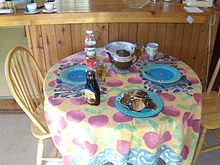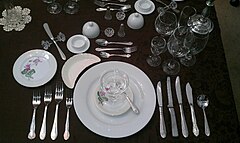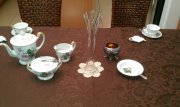Table setting (laying a table) or place setting refers to the way to set a table with tableware—such as eating utensils and for serving and eating. The arrangement for a single diner is called a place setting. The practice of dictating the precise arrangement of tableware has varied across cultures and historical periods.
Place setting[edit]
Informal settings generally have fewer utensils and dishes but use a layout based on more formal settings. Utensils are arranged in the order and according to the manner in which the dinner will use them. In the West, forks, bread plate, butter knife, and napkin generally are placed to the left of the dinner plate, and knives, spoons, stemware and tumblers, cups, and saucers to the right. (By contrast, formal settings in Armenia and Turkey place the fork to the right of the dinner plate.)Sauceboats and serving dishes, when used, either are placed on the table or, more formally, may be kept on a side table.
Informal[edit]
At an informal setting, fewer utensils are used and serving dishes are placed on the table. Sometimes the cup and saucer are placed on the right side of the spoon, about four inches from the edge of the table. Often, in less formal settings, the napkin should be in the wine glass. However, such objects as napkin rings are very rare in the United Kingdom, Spain, Mexico, or Italy.
Formal[edit]
Utensils are placed about an inch from the edge of the table, with all placed either upon the same invisible baseline or upon the same invisible median line. Utensils in the outermost position are used first (for example, a soup spoon and a salad fork, then the dinner fork and the dinner knife). The blades of the knives are turned toward the plate. Glasses are placed an inch or so above the knives, also in the order of use: white wine, red wine, dessert wine, and water tumbler.
Formal dinner[edit]
The most formal dinner is served from the kitchen. When the meal is served, in addition to the central plate (a service plate or dinner plate at supper; at luncheon, a service plate or luncheon plate) at each place there are a bread roll (generally on a bread plate, sometimes in the napkin), napkin, and flatware (knives and spoons to the right of the central plate, and forks to the left). Coffee is served in Butler Service style in demitasses, and a spoon placed on the saucer to the right of each handle. Serving dishes and utensils are not placed on the table for a formal dinner.[1] The only exception in the West to these general rules is the protocol followed at the Spanish royal court, which was also adopted by the Austrian court, in which all flatware was placed to the right of the central plate for each diner.
At a less formal dinner, not served from the kitchen, the dessert fork and spoon can be set above the plate, fork pointing right, spoon pointing left.[2]
Gallery[edit]
| Formal dining | ||||||||||||||||||||||||||
|---|---|---|---|---|---|---|---|---|---|---|---|---|---|---|---|---|---|---|---|---|---|---|---|---|---|---|
Source : wikipedia















No comments:
Post a Comment